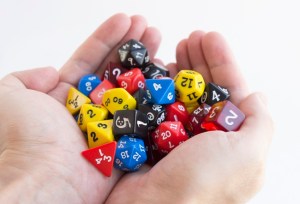
Random Rolls Are Awesome
Random rolls in tabletop role-playing games often get criticized. People say the tables lack context and don’t fit the situation at hand. The worst accusation, however, is that using random tables means the session will be bad because the game master is lazy.
Let’s start with the most serious criticism. Does using random tables mean the session will be bad? Of course not. Sessions can be bad for many reasons. I’ve prepped highly detailed sessions and they were awful. I’ve gone in with no prep and they were awful. I’ve used random tables and sessions were bad. I’ve not used random tables and sessions were bad.
Bad sessions are their own beasts. Figuring out what makes them fall flat is a complex undertaking. My point is simply this: using random tables does not inherently mean the session will be bad.
The criticism that random tables lack context is what I want to address, because there is an element of truth to it.
Random tables can’t account for every possible situation at the table. That’s just not possible. So many things can happen during a role-playing session that it’s hard for random tables to align perfectly with the moment at hand.
Sometimes they do. For example, I created Carousing Tables for The Book of Random Tables: Inns and Taverns. Those tables cover almost any moment when the party is cutting loose at an inn.
But in another of my books, I created the table “Items in a Troll’s Cave.” When was the last time your players explored a troll cave? Probably not recently. Yet the table is still useful. Let me explain.
Random Rolls Make the Story Better
The “Items in a Troll’s Cave” can be used when the party is searching a hermit’s cave or a bandit’s cave, or even a hag’s hut. Only slight modifications, if any, would be needed.
However, rolling something out of place, doesn’t have to be bad. Did you roll an item that doesn’t fit? Did you roll a situation that makes no sense?
These aren’t bugs. They are features.
An odd item can instantly become a compelling story point. Why did the hermit keep a chest full of brass buttons? Why was the monk carrying a taxidermied lizard in his backpack? Why does the innkeeper hide a jar of dead bees under the counter?
In an urban thief campaign, maybe a party member steals an item and you roll “Map to an ancient fortress.” Uh-oh. What now?
Don’t worry. This is where players get hooked. The character who stole the map might become obsessed with finding the fortress and convince the others to join in.
And again, don’t worry. This is where tabletop role-playing games get fun. Start improvising. Use more random tables.
But some DMs will say, “That will drag the characters away from my campaign!”
First, no one said the fortress is thousands of miles away. Maybe it’s beneath the city. Maybe it’s a short ride down the coast.
Will this distract from your campaign? Only if you let it. Start brainstorming how the fortress can add a new dimension to the campaign, one you never would have discovered on your own.
Random Tables Serve the Game
Random tables are your servants at the table. Use them however you wish. Ignore rolls, reroll them, or twist them into something new. But remember, odd results are features, not bugs.
You can check out my books of random tables on Amazon, DriveThruRPG, or Dicegeeks.
Read more at this site
